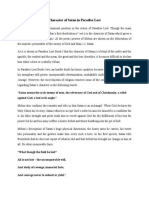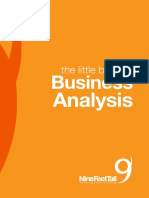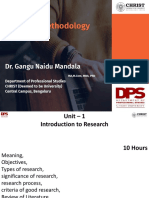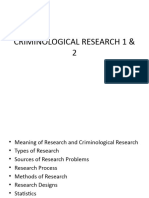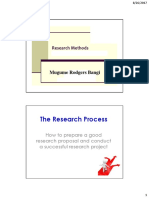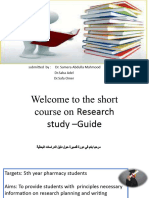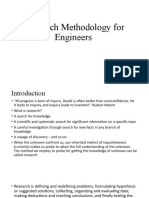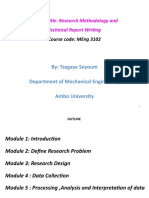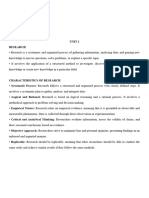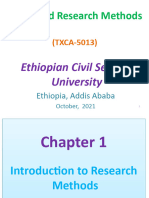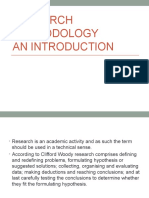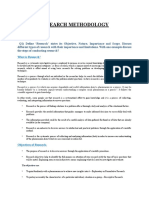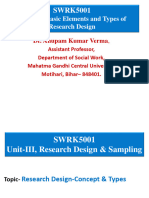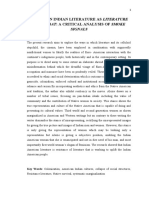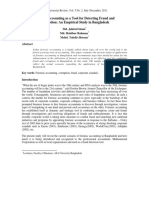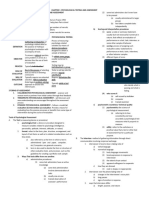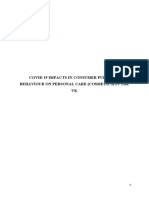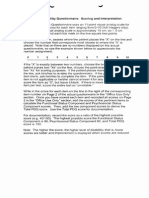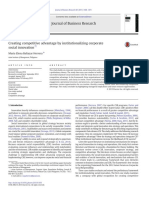0 ratings0% found this document useful (0 votes)
20 viewsTEXT
TEXT
Uploaded by
Muhammad AurangzaibThis document provides an introduction to research methodology. It discusses key concepts such as the meaning of research, objectives of research, characteristics of good research, types of research including descriptive vs analytical and quantitative vs qualitative, and motivations for conducting research. The overall purpose is to define what constitutes research and explore different approaches and considerations for effective research.
Copyright:
© All Rights Reserved
Available Formats
Download as DOCX, PDF, TXT or read online from Scribd
TEXT
TEXT
Uploaded by
Muhammad Aurangzaib0 ratings0% found this document useful (0 votes)
20 views8 pagesThis document provides an introduction to research methodology. It discusses key concepts such as the meaning of research, objectives of research, characteristics of good research, types of research including descriptive vs analytical and quantitative vs qualitative, and motivations for conducting research. The overall purpose is to define what constitutes research and explore different approaches and considerations for effective research.
Copyright
© © All Rights Reserved
Available Formats
DOCX, PDF, TXT or read online from Scribd
Share this document
Did you find this document useful?
Is this content inappropriate?
This document provides an introduction to research methodology. It discusses key concepts such as the meaning of research, objectives of research, characteristics of good research, types of research including descriptive vs analytical and quantitative vs qualitative, and motivations for conducting research. The overall purpose is to define what constitutes research and explore different approaches and considerations for effective research.
Copyright:
© All Rights Reserved
Available Formats
Download as DOCX, PDF, TXT or read online from Scribd
Download as docx, pdf, or txt
0 ratings0% found this document useful (0 votes)
20 views8 pagesTEXT
TEXT
Uploaded by
Muhammad AurangzaibThis document provides an introduction to research methodology. It discusses key concepts such as the meaning of research, objectives of research, characteristics of good research, types of research including descriptive vs analytical and quantitative vs qualitative, and motivations for conducting research. The overall purpose is to define what constitutes research and explore different approaches and considerations for effective research.
Copyright:
© All Rights Reserved
Available Formats
Download as DOCX, PDF, TXT or read online from Scribd
Download as docx, pdf, or txt
You are on page 1of 8
Introduction to research methodology
1. 1. INTRODUCTION TO RESEARCH METHODOLOGY Mr. Rajasekar Ramalingam Faculty
– Department of Information Technology College of Applied Sciences – Sur Ministry of
Higher Education Sultanate of Oman Rajasekar.sur@cas.edu.om vrrsekar@yahoo.com
2. 2. TABLE OF CONTENT 1.1 MEANING OF RESEARCH 1.2 OBJECTIVES OF RESEARCH
1.3 CHARACTERISTICS OF RESEARCH 1.4 CRITERIA OF A GOOD RESEARCH 1.5
QUALITIES OF GOOD RESEARCH 1.6 RESEARCH MOTIVATIONS 1.7 TYPES OF
RESEARCH 1.8 PROBLEMS IN RESEARCH 1.9 RESEARCH APPROACHES 1.10
RESEARCH PROCESS 1.11 LITERATURE REVIEW 1.12 HYPOTHESIS 1.13 CRITERIA
OF GOOD RESEARCH 1.14 PROBLEMS ENCOUNTERED BY RESEARCHERS Rajasekar
Ramalingam - Research Methodology 2
3. 3. Rajasekar Ramalingam - Research Methodology 3 INTRODUCTION TO RESEARCH
METHODS
4. 4. 1.1 MEANING OF RESEARCH • Research in general refers to…. o A search for
knowledge. o A scientific and systematic search for relevant information on a specific topic. o
Research is an art of scientific investigation. o Research is a careful investigation or inquiry
especially through search for new facts in any branch of knowledge. o “Redman and Mory”
define research as a “systematized effort to gain new knowledge.” o Research is a
movement, a movement from the known to the unknown. o A voyage of discovery. o “Clifford
Woody” defines research as “a comprises defining and redefining problems, formulating
hypothesis or suggested solutions; collecting, organizing and evaluating data; making
deductions and reaching conclusions; and at last carefully testing the conclusions to
determine whether they fit the formulating hypothesis”. o D. Slesinger and M. Stephenson,
defines research is “the manipulation of things, concepts or symbols for the purpose of
generalizing to extend, correct or verify knowledge, whether that knowledge aids in
construction of theory or in the practice of an art.” o Research is the systematic process of
collecting and analyzing information (data) in order to increase our understanding of the
phenomenon about which we are concerned or interested. Rajasekar Ramalingam -
Research Methodology 4
5. 5. 1.2 OBJECTIVES OF RESEARCH • The purpose of research is to discover answers
through the application of scientific procedures. • The main aim of research is to find out the
truth which is hidden and which has not been discovered as yet. • Research objectives falling
into a number of following broad groupings: o Exploratory or Formulative Research studies:
To gain familiarity with a phenomenon or to achieve new insights into it. o Descriptive
Research studies : To depict accurately the characteristics of a particular individual, situation
or a group o Diagnostic Research studies: To determine the frequency with which something
occurs or with which it is associated with something else. o Hypothesis-Testing Research
studies: To test a hypothesis of a causal relationship between variables. Rajasekar
Ramalingam - Research Methodology 5
6. 6. 1.3 CHARACTERISTICS OF RESEARCH • Research is directed towards the solution of a
problem. • Research is based upon observable experience or empirical evidence. • Research
demands accurate observation and description. • Research involves gathering new data
from primary sources or using existing data for a new purpose. • Research activities are
characterized by carefully designed procedures. • Research requires expertise i.e., skill
necessary to carryout investigation, search the related literature and to understand and
analyze the data gathered. • Research is objective and logical – applying every possible test
to validate the data collected and conclusions reached. • Research involves the quest for
answers to unsolved problems. • Research requires courage. • Research is characterized by
patient and unhurried activity. • Research is carefully recorded and reported. Rajasekar
Ramalingam - Research Methodology 6
7. 7. 1.4 CRITERIA OF A GOOD RESEARCH • Purpose clearly defined. • Research process
detailed. • Research design thoroughly planned. • High ethical standards applied. •
Limitations frankly revealed. • Adequate analysis for decision maker’s needs. • Findings
presented unambiguously. • Conclusions justified. • Researcher’s experience reflected.
Rajasekar Ramalingam - Research Methodology 7
8. 8. 1.5 QUALITIES OF GOOD RESEARCH • Systematic • Logical • Empirical • Replicable •
Creative • Use of multiple methods Rajasekar Ramalingam - Research Methodology 8
9. 9. 1.6 RESEARCH MOTIVATIONS • The possible motives for doing research are: • Desire to
get a research degree along with its consequential benefits • Desire to face the challenge in
solving the unsolved problems. • Desire to get intellectual joy of doing some creative work •
Desire to be of service to society • Desire to get respectability. • Other motivating factors are:
directives of government, employment conditions, curiosity about new things, desire to
understand causal relationships, social thinking and awakening. Rajasekar Ramalingam -
Research Methodology 9
10. 10. Rajasekar Ramalingam - Research Methodology 10 Types of Research Descriptive Vs
Analytical Research Applied Vs. Fundamental Research Quantitative Vs. Qualitative
Research Conceptual Vs. Empirical Research Other Types of Research One time Research
Longitudinal Research Historical Research Diagnostic Research Experimental Research
Exploratory Research 1.7 TYPES OF RESEARCH
11. 11. 1. Descriptive Vs Analytical research. Descriptive research: • Includes surveys and fact-
finding enquiries of different kinds. • The major purpose of descriptive research is description
of the state of affairs as it exists at present. • The main characteristic of this method is that
the researcher has no control over the variables; he can only report what has happened or
what is happening. • Researchers discover causes even when they cannot control the
variables. • The methods of research utilized in descriptive research are survey methods of
all kinds, including comparative and correlational methods. Analytical research: • The
researcher has to use facts or information already available, and analyze these to make a
critical evaluation of the material. Rajasekar Ramalingam - Research Methodology 11
12. 12. 2. Applied vs. Fundamental. Applied research: • Aims at finding a solution for an
immediate problem facing a society or an industrial/business organization. • The central aim
of applied research is to discover a solution for some pressing practical problem. • Example
for Applied research. • Research aimed at certain conclusions (say, a solution) facing a
concrete social or business problem. • Research to identify social, economic or political
trends that may affect a particular institution or the copy research or the marketing research
or evaluation research. Fundamental research: • is mainly concerned with generalizations
and with the formulation of a theory. • Fundamental research is directed towards finding
information that has a broad base of applications • Examples of fundamental research: •
Research concerning some natural phenomenon or relating to pure mathematics. •
Research carried on with a view to make generalizations about human behavior. Rajasekar
Ramalingam - Research Methodology 12
13. 13. 3. Quantitative vs. Qualitative: Quantitative research: • is based on the measurement of
quantity or amount. • It is applicable to phenomena that can be expressed in terms of
quantity. • Quantitative Research is used to quantify the problem by way of generating
numerical data or data that can be transformed into usable statistics. • It is used to quantify
attitudes, opinions, behaviors, and other defined variables – and generalize results from a
larger sample population. • Quantitative Research uses measurable data to formulate facts
and uncover patterns in research. • Quantitative data collection methods are much more
structured than Qualitative data collection methods. • Quantitative data collection methods
include various forms of surveys – online surveys, paper surveys, mobile surveys and kiosk
surveys, face-to-face interviews, telephone interviews, longitudinal studies, website
interceptors, online polls, and systematic observations. Qualitative research: • is concerned
with qualitative phenomenon. • Phenomena relating to or involving quality or kind. •
Qualitative Research is primarily exploratory research. • It is used to gain an understanding
of underlying reasons, opinions, and motivations. • It provides insights into the problem or
helps to develop ideas or hypotheses for potential quantitative research. • Qualitative
Research is also used to uncover trends in thought and opinions, and dive deeper into the
problem. • Qualitative data collection methods vary using unstructured or semi-structured
techniques. • Some common methods include focus groups (group discussions), individual
interviews, and participation/observations. • The sample size is typically small, and
respondents are selected to fulfill a given quota. Rajasekar Ramalingam - Research
Methodology 13
14. 14. 4. Conceptual vs. Empirical: Conceptual research: • is that related to some abstract
idea(s) or theory. • It is generally used by philosophers and thinkers to develop new concepts
or to reinterpret existing ones. Empirical research: • relies on experience or observation
alone, often without due regard for system and theory. • It is data-based research, coming up
with conclusions which are capable of being verified by observation or experiment. • We can
also call it as experimental type of research. • In such a research it is necessary to get at
facts firsthand, at their source, and actively to go about doing certain things to stimulate the
production of desired information. • In such a research, the researcher must first provide
himself with a working hypothesis or guess as to the probable results. • He then works to get
enough facts (data) to prove or disprove his hypothesis. • He then sets up experimental
designs which he thinks will manipulate the persons or the materials concerned so as to
bring forth the desired information. • Evidence gathered through experiments or empirical
studies is today considered to be the most powerful support possible for a given hypothesis.
Rajasekar Ramalingam - Research Methodology 14
15. 15. 5. Some other types of research • One-time Research: Research confined to a single
time period. • Longitudinal Research: Research carried on over several time periods. •
Diagnostic Research: It is also called clinical research which aims at identifying the causes of
a problem, frequency with which it occur and the possible solutions for it. • Exploratory
Research: It is the preliminary study of an unfamiliar problem, about which the researcher
has little or no knowledge. It is aimed to gain familiarity with the problem, to generate new
ideas or to make a precise formulation of the problem. Hence it is also known as formulative
research. • Experimental Research: It is designed to assess the effect of one particular
variable on a phenomenon by keeping the other variables constant or controlled. • Historical
Research: It is the study of past records and other information sources, with a view to find
the origin and development of a phenomenon and to discover the trends in the past, in order
to understand the present and to anticipate the future. Rajasekar Ramalingam - Research
Methodology 15
16. 16. 1.8 PROBLEMS IN RESEARCH • Not similar to science • Uncontrollable variables •
Human tendencies • Time and money • Lack of computerization • Lack of scientific training in
the methodology of research • Insufficient interaction between university research
departments and business establishments • Lack of confidence on the part of business units
to give information • Lack of code of conduct • Difficulty of adequate and timely secretarial
assistance • Poor library management and functioning • Difficulty of timely availability of
published data. • Ignorance • Research for the sake of research-limited practical utility
though they may use high sounding business jargon. Rajasekar Ramalingam - Research
Methodology 16
17. 17. 1.9 RESEARCH APPROACHES There are two basic approaches to research •
Quantitative approach • Qualitative approach Rajasekar Ramalingam - Research
Methodology 17 Research Approaches Quantitative Approach Inferential approach
Experimental approach Simulation approach Qualitative Approach
18. 18. 1. Quantitative approach • Quantitative approach involves the generation of data in
quantitative form which can be subjected to rigorous quantitative analysis in a formal and
rigid fashion. • This approach can be further sub-classified into 1) Inferential approach 2)
Experimental approach 3) Simulation approach • The purpose of inferential approach to
research is to form a data base from which to infer characteristics or relationships of
population. • This usually means survey research where a sample of population is studied
(questioned or observed) to determine its characteristics, and it is then inferred that the
population has the same characteristics. • Experimental approach is characterized by much
greater control over the research environment and in this case some variables are
manipulated to observe their effect on other variables. • Simulation approach involves the
construction of an artificial environment within which relevant information and data can be
generated. • This permits an observation of the dynamic behavior of a system (or its sub-
system) under controlled conditions. • Simulation approach useful in building models for
understanding future conditions. Rajasekar Ramalingam - Research Methodology 18
19. 19. 2. Qualitative approach • Qualitative approach to research is concerned with subjective
assessment of attitudes, opinions and behavior. • Research in such a situation is a function
of researcher’s insights and impressions. • Such an approach to research generates results
either in non-quantitative form or in the form which are not subjected to rigorous quantitative
analysis. • Generally, the techniques of focus group interviews, projective techniques and
depth interviews are used. Rajasekar Ramalingam - Research Methodology 19
20. 20. 1.10 RESEARCH PROCESS • Research process consists of series of actions or steps
necessary to effectively carry out research and the desired sequencing of these steps. • The
chart shown in Figure well illustrates a research process. • The chart indicates that the
research process consists of a number of closely related activities, as shown through I to VII.
• However, the following order concerning various steps provides a useful procedural
guideline regarding the research process: Rajasekar Ramalingam - Research Methodology
20
21. 21. Rajasekar Ramalingam - Research Methodology 21
22. 22. (1) Formulating the research problem (2) Extensive literature survey (3) Developing the
hypothesis (4) Preparing the research design (5) Determining sample design (6) Collecting
the data (7) Execution of the project (8) Analysis of data (9) Hypothesis testing (10)
Generalizations and interpretation (11) Preparation of the report or presentation of the
results Rajasekar Ramalingam - Research Methodology 22
23. 23. a) What is a Research problem? • The term ‘problem’ means a question or issue to be
examined. • Research Problem refers to some difficulty/need which a researcher
experiences in the context of either theoretical or practical situation and wants to obtain a
solution for the same. b) How do we know we have a research problem? • Customer
complaints • Conversation with company employees • Observation of inappropriate behavior
or conditions in the firm • Deviation from the business plan • Success of the firm’s
competitor’s • Relevant reading of published material (trends, regulations) • Company
records and reports. c) Definition of the problem involves two activities: • Identification /
Selection of the Problem • Formulation of the Problem Rajasekar Ramalingam - Research
Methodology 23
24. 24. d) Identification/selection of the research problem. • This step involves identification of a
few problems and selection of one out of them, after evaluating the alternatives against
certain selection criteria. e) Sources of problems. • Reading • Academic Experience • Daily
Experience • Exposure to Field Situations • Consultations • Brainstorming • Research •
Intuition f) Criteria of Selection • The selection of one appropriate researchable problem out
of the identified problems requires evaluation of those alternatives against certain criteria.
They are: • Internal / Personal criteria – Researcher’s Interest, Researcher’s Competence,
Researcher’s own Resource: finance and time. • External Criteria or Factors – Research-
ability of the problem, Importance and Urgency, Novelty of the Problem, Feasibility, Facilities,
Usefulness and Social Relevance, Research Personnel. Rajasekar Ramalingam - Research
Methodology 24
25. 25. g) Definition/formulation of the research problem. • Formulation is the process of refining
the research ideas into research questions and objectives. • Formulation means translating
and transforming the selected research problem/topic/idea into a scientifically researchable
question. It is concerned with specifying exactly what the research problem is. • Problem
definition or Problem statement is a clear, precise and succinct statement of the question or
issue that is to be investigated with the goal of finding an answer or solution. • There are two
ways of stating a problem: • Posting question / questions • Making declarative statement /
statements h) Process involved in defining the problem • Statement of the problem in a
general way. • Understanding the nature of problem. • Surveying the available literature. •
Developing ideas through discussions. • Rephrasing the research problem. i) Criteria of a
good research problem • Clear and Unambiguous • Empirical • Verifiable • Interesting • Novel
and Original • Availability of Guidance Rajasekar Ramalingam - Research Methodology 25
26. 26. j) Defining problem, results in clear cut research objectives. k) Establishment of research
objectives • Research Objectives are the specific components of the research problem,
which you’ll be working to answer or complete, in order to answer the overall research
problem. - Churchill, 2001 • The objectives refer to the questions to be answered through the
study. They indicate what we are trying to get from the study or the expected results /
outcome of the study. • Research Objectives should be clear and achievable, as they directly
assist in answering the research problem. • The objectives may be specified in the form of
either statements or questions. • Generally, they are written as statements, using the word
“to”. (For example, ‘to discover …’, ‘to determine …’, ‘to establish …’, etc. ) Rajasekar
Ramalingam - Research Methodology 26
27. 27. 1.11 LITERATURE REVIEW • Literature Review is the documentation of a
comprehensive review of the published and unpublished work from secondary sources of
data in the areas of specific interest to the researcher. • The main aim is to find out problems
that are already investigated and those that need further investigation. • It is an extensive
survey of all available past studies relevant to the field of investigation. • It gives us
knowledge about what others have found out in the related field of study and how they have
done so. a) Purpose of review • To gain a background knowledge of the research topic. • To
identify the concepts relating to it, potential relationships between them and to formulate
researchable hypothesis. • To identify appropriate methodology, research design, methods
of measuring concepts and techniques of analysis. • To identify data sources used by other
researchers. • To learn how others structured their reports. Rajasekar Ramalingam -
Research Methodology 27
28. 28. b) How to conduct the literature survey? • Identify the relevant sources. • Extract and
Record relevant information. • Write-up the Literature Review. c) Sources of literature •
Books and Journals • Electronic Databases o Bibliographic Databases o Abstract Databases
o Full-Text Databases • Govt. and Industry Reports • Internet • Research Dissertations /
Thesis d) Recording the literature • The most suitable method of recording notes is the card
system. • The recording system involves use of two sets of cards: 1) Source cards (3”x 5”) –
used for noting bibliographic information. 2) Note cards (5”x 8”) – used for actual note taking.
Rajasekar Ramalingam - Research Methodology 28
29. 29. 1. Source cards • Source Cards serve two purposes: • Provide documentary information
for foot notes. • It is used for compiling bibliography to be given at the end of the report. •
Source Cards can be coded by a simple system in order to relate them to the corresponding
note cards. • Marking a combination of letters and a number on the right hand top corner that
begins with ‘C’. For example; C1, C2 etc. OR • Marking the letter ‘B’ or ‘J’ or ‘R’ (B=Books,
J=Journal, R=Report) on the left hand top corner. • The recording of bibliographic information
should be made in proper bibliographic format. • The format for citing a book is: Author’s
name, (year), Title of the book, Place of publication, Publisher’s name. • For Example;
Koontz Harold (1980), Management, New Delhi, McGraw-Hill International. • • The format for
citing a journal article is: Author’s name, (year), Title of the article, Journal name, Volume
(number), pages. • For Example; Sheth J.N (1973), A Model of Industrial Buying Behavior,
Journal of Marketing, 37(4), 50- 56. Rajasekar Ramalingam - Research Methodology 29
30. 30. 2. Note cards • Detailed Information extracted from a printed source is recorded on the
note cards. • It is desirable to note a single fact or idea on each card, on one side only. • How
to write the review? • There are several ways of presenting the ideas of others within the
body of the paper. • For Example; If you are referring the major influencing factors in the
Sheth’s model of Industrial Buying Behavior, it can be written as, Sheth (1973, p-50) has
suggested that, there are a number of influencing factors …….. • According to Sheth (1973)
model of industrial buying behavior, there are a number of influencing factors…….. • In some
models of industrial buying behavior, there are a number of influencing factors (Sheth, 1973).
• In some models of industrial buying behavior, there are a number of influencing factors1. •
Sheth J.N (1973), A Model of Industrial Buying Behavior, Journal of Marketing, 37(4), 50- 56.
Rajasekar Ramalingam - Research Methodology 30
31. 31. e) How to write the review? • There are several ways of presenting the ideas of others
within the body of the paper. • For Example; If you are referring the major influencing factors
in the Sheth’s model of Industrial Buying Behavior, it can be written as, • Sheth (1973, p-50)
has suggested that, there are a number of influencing factors …….. • According to Sheth
(1973) model of industrial buying behavior, there are a number of influencing factors…….. •
In some models of industrial buying behavior, there are a number of influencing factors
(Sheth, 1973). • In some models of industrial buying behavior, there are a number of
influencing factors1. • Sheth J.N (1973), A Model of Industrial Buying Behavior, Journal of
Marketing, 37(4), 50- 56. f) Points to be kept in mind while reviewing literature. • Read
relevant literature. • Refer original works. • Read with comprehension. • Read in time. • Index
the literature. Rajasekar Ramalingam - Research Methodology 31
32. 32. 1.12 HYPOTHESIS a. Hypothesis • A hypothesis is an assumption about relations
between variables. • Hypothesis can be defined as a logically conjectured relationship
between two or more variables expressed in the form of a testable statement. • Relationships
are conjectured on the basis of the network of associations established in the theoretical
framework formulated for the research study. b. Variables • Anything that can vary can be
considered as a variable. • A variable is anything that can take on differing or varying values.
o For example; Age, Production units, Absenteeism, Sex, Motivation, Income, Height, Weight
etc. • Note: The values can differ at various times for the same object or person (or) at the
same time for different objects or persons. • A variable is a characteristic that takes on two or
more values whereas; an attribute is a specific value on a variable (qualitative). o For
example; o The variable SEX/GENDER has 2 attributes - Male and Female. o The variable
AGREEMENT has 5 attributes – Strongly Agree, Agree, Neutral, Disagree, and Strongly
Disagree. Rajasekar Ramalingam - Research Methodology 32
33. 33. c. Types of variables • Explanatory Vs Extraneous Variable • The variables selected for
analysis are called explanatory variables and all other variables that are not related to the
purpose of the study but may affect the dependent variable are extraneous. • Dependant Vs
Independent Variable • The variable that changes in relationship to changes in another
variable(s) is called dependant variable. • The variable whose change results in the change
in another variable is called an independent variable. • OR • An independent variable is the
one that influences the dependant variable in either a positive or negative way. Rajasekar
Ramalingam - Research Methodology 33
34. 34. d. Hypothesis • Research Hypothesis is a predictive statement that relates an
independent variable to a dependant variable. o Hypothesis must contain atleast one
independent variable and one dependant variable. • Hypotheses are tentative, intelligent
guesses as to the solution of the problem. • Hypothesis is a specific statement of prediction.
It describes in concrete terms what you expect to happen in the study. • Hypothesis is an
assumption about the population of the study. • It delimits the area of research and keeps the
researcher on the right track. e. Problem (vs) Hypothesis • Hypothesis is an assumption,
which can be tested and can be proved to be right or wrong. • A problem is a broad question
which cannot be directly tested. A problem can be scientifically investigated after converting
it into a form of hypothesis. Rajasekar Ramalingam - Research Methodology 34
35. 35. f. Characteristics of Hypothesis • Conceptual Clarity - It should be clear and precise. •
Specificity - It should be specific and limited in scope. • Consistency - It should be consistent
with the objectives of research. • Testability - It should be capable of being tested. •
Expectancy - It should state the expected relationships between variables. • Simplicity - It
should be stated as far as possible in simple terms. • Objectivity - It should not include value
judgments, relative terms or any moral preaching. • Theoretical Relevance - It should be
consistent with a substantial body of established or known facts or existing theory. •
Availability of Techniques – Statistical methods should be available for testing the proposed
hypothesis. Rajasekar Ramalingam - Research Methodology 35
36. 36. g. Sources of Hypothesis • Discussions with colleagues and experts about the problem,
its origin and objectives in seeking a solution. • Examination of data and records for possible
trends, peculiarities. • Review of similar studies. • Exploratory personal investigation /
Observation. • Logical deduction from the existing theory. • Continuity of research. • Intuition
and personal experience. Rajasekar Ramalingam - Research Methodology 36
37. 37. h. Types of Hypothesis Descriptive Hypothesis • These are assumptions that describe
the characteristics (such as size, form or distribution) of a variable. The variable may be an
object, person, organization, situation or event. • Examples: “Public enterprises are more
amenable for centralized planning”. Relational Hypothesis [Explanatory Hypothesis] • These
are assumptions that describe the relationship between two variables. The relationship
suggested may be positive, negative or causal relationship. • Examples: “Families with
higher incomes spend more for recreation”. Casual Hypothesis • Causal Hypothesis state
that the existence of or change in one variable causes or leads to an effect on another
variable. The first variable is called the independent variable and the latter is the dependant
variable. Rajasekar Ramalingam - Research Methodology 37
38. 38. Null Hypothesis • When a hypothesis is stated negatively, it is called null hypothesis. It is
a ‘no difference’, ‘no relationship’ hypothesis. ie., It states that, no difference exists between
the parameter and statistic being compared to or no relationship exists between the
variables being compared. It is usually represented as HO or H0. • Example: H0: There is no
relationship between a family’s income and expenditure on recreation. Alternate Hypothesis •
It is the hypothesis that describes the researcher’s prediction that, there exist a relationship
between two variables or it is the opposite of null hypothesis. It is represented as HA or H1. •
Example: HA: There is a definite relationship between family’s income and expenditure on
recreation. Rajasekar Ramalingam - Research Methodology 38
39. 39. i. Functions or role of hypothesis • It gives a definite point to the investigation and
provides direction to the study. • It determines the data needs. • It specifies the sources of
data. • It suggests which type of research is likely to be more appropriate. • It determines the
most appropriate technique of analysis. • It contributes to the development of theory.
Rajasekar Ramalingam - Research Methodology 39
40. 40. 1.13 CRITERIA OF GOOD RESEARCH • The scientific research must satisfy the
following criteria: • The purpose of the research should be clearly defined and common
concepts be used. • The research procedure used should be described in sufficient detail to
permit another researcher to repeat the research for further advancement, keeping the
continuity of what has already been attained. • The procedural design of the research should
be carefully planned to yield results that are as objective as possible. • The researcher
should report with complete frankness, flaws in procedural design and estimate their effects
upon the findings. • The analysis of data should be sufficiently adequate to reveal its
significance and the methods of analysis used should be appropriate. The validity and
reliability of the data should be checked carefully. • Conclusions should be confined to those
justified by the data of the research and limited to those for which the data provide an
adequate basis. • Greater confidence in research is warranted if the researcher is
experienced, has a good reputation in research and is a person of integrity. Rajasekar
Ramalingam - Research Methodology 40
41. 41. 1.14 PROBLEMS ENCOUNTERED BY RESEARCHERS • The lack of a scientific
training in the methodology of research. • Insufficient interaction between the university
research departments on one side and business establishments, government departments
and research institutions on the other side. • The need for generating the confidence that the
information/data obtained from a business unit will not be misused. • Research studies
overlapping one another are undertaken quite often for want of adequate information. •
There does not exist a code of conduct for researchers and inter-university and
interdepartmental rivalries are also quite common. • Researchers in our country also face the
difficulty of adequate and timely secretarial assistance, including computerial assistance. •
Library management and functioning is not satisfactory at many places and much of the time
and energy of researchers are spent in tracing out the books, journals, reports, etc., rather
than in tracing out relevant material from them. • There is also the problem that many of our
libraries are not able to get copies of old and new Acts/Rules, reports and other government
publications in time. • There is also the difficulty of timely availability of published data from
various government and other agencies doing this job in our country. • The problem of
conceptualization and also problems relating to the process of data collection and related
things. Rajasekar Ramalingam - Research Metho
You might also like
- 009 Installation of Pumps Risk AssessmentDocument2 pages009 Installation of Pumps Risk Assessmentgangadharan000100% (14)
- Iip Project On Cease FireDocument74 pagesIip Project On Cease FireSomraj Pathak100% (1)
- Character of Satan in Paradise LostDocument3 pagesCharacter of Satan in Paradise LostMuhammad Aurangzaib100% (2)
- Introduction To Research MethodologyDocument41 pagesIntroduction To Research Methodologyskirubaarun100% (4)
- Fact Sheet BUSINESS RESEARCH METHODSDocument11 pagesFact Sheet BUSINESS RESEARCH METHODSmaham azizNo ratings yet
- Measuring and Improving Walkability in DelhiDocument3 pagesMeasuring and Improving Walkability in DelhiKarishma PrasadNo ratings yet
- Introduction To Business AnalystDocument69 pagesIntroduction To Business AnalystJayna Wampy100% (3)
- Introduction To Research Methodology: Mr. Rajasekar RamalingamDocument41 pagesIntroduction To Research Methodology: Mr. Rajasekar RamalingamJitendra Singh Yadav100% (1)
- RM Unit 1-MergedDocument364 pagesRM Unit 1-MergedAnirudh Kar 1912705No ratings yet
- Basic Concepts of Research MethodologyDocument41 pagesBasic Concepts of Research MethodologyAeida IndiaNo ratings yet
- Research Methodology Unit-1Document27 pagesResearch Methodology Unit-1Sushma ReddyNo ratings yet
- RM Mod 1Document34 pagesRM Mod 1sumitsuman732No ratings yet
- Business Research Methods: Lec # 2 Types of Research Manager-Research RelationshipDocument28 pagesBusiness Research Methods: Lec # 2 Types of Research Manager-Research Relationshiparbaz khanNo ratings yet
- Notes-Introduction To Research MethodologyDocument165 pagesNotes-Introduction To Research Methodologymacklinaprotas01No ratings yet
- Seminar Course First HandoutDocument30 pagesSeminar Course First HandoutMohammad Edris Amarkhil100% (1)
- Criminological Research 1 2Document211 pagesCriminological Research 1 2jasterserognas100% (1)
- Research HelpDocument128 pagesResearch HelpSamuel AcidriNo ratings yet
- Research Methodology: Prof. Deepak Nagaria BIET, JhansiDocument45 pagesResearch Methodology: Prof. Deepak Nagaria BIET, JhansiHitendra SinghNo ratings yet
- Chapter 1 Introduction To ResearchDocument32 pagesChapter 1 Introduction To ResearchBijay ShresthaNo ratings yet
- Ec 647 Ee 9Document19 pagesEc 647 Ee 9Hussain DUrraniNo ratings yet
- CH 1 RMDocument30 pagesCH 1 RMTMIMITWJ2030No ratings yet
- Research 5th SabaDocument140 pagesResearch 5th Sabattaass76898No ratings yet
- ResearchDocument12 pagesResearchMohamed SalemNo ratings yet
- Research Methgodology - IntroductionDocument33 pagesResearch Methgodology - IntroductionVikash TiwariNo ratings yet
- UG Physiology Sem6 DSE4TDocument37 pagesUG Physiology Sem6 DSE4TBiksham JimmidiNo ratings yet
- Research MethodsDocument71 pagesResearch MethodsBrian PushNo ratings yet
- Research MethodsDocument36 pagesResearch MethodsDeboo X XavierNo ratings yet
- Importance of Educational Research V2Document51 pagesImportance of Educational Research V2ainNo ratings yet
- Research MethodologyDocument14 pagesResearch Methodologymm1979No ratings yet
- Unit 9Document31 pagesUnit 9Samikshya TimalsinaNo ratings yet
- Chapter 1 - Research Methodology - IntroductionDocument29 pagesChapter 1 - Research Methodology - IntroductionMilion dugumaNo ratings yet
- Paper-1 Research MethodologyDocument17 pagesPaper-1 Research Methodologyoskruthika94No ratings yet
- Research Methodology NUCS - 1pdfDocument44 pagesResearch Methodology NUCS - 1pdfkhanlalagh134No ratings yet
- Chap 1Document39 pagesChap 1Amanuel mergiaNo ratings yet
- Research Methodology Presentation1Document20 pagesResearch Methodology Presentation1SIMON JOSIAHNo ratings yet
- What Is ResearchDocument5 pagesWhat Is ResearchAbhinandan SahooNo ratings yet
- Crim 7.2Document5 pagesCrim 7.2Al FernandezNo ratings yet
- Chapter One Introduction To Research MethodologyDocument27 pagesChapter One Introduction To Research MethodologyBaruk Umeta DegoNo ratings yet
- Research Methodology: Dr. P. Suganda DeviDocument96 pagesResearch Methodology: Dr. P. Suganda DeviK SrivarunNo ratings yet
- INTRODUCTION TO RESEARCH METHODS - Lesson 1Document20 pagesINTRODUCTION TO RESEARCH METHODS - Lesson 1Alice UmutoniNo ratings yet
- Unit 1Document14 pagesUnit 1Arjun MNo ratings yet
- Types of ResearchDocument28 pagesTypes of Researchbinilucky224No ratings yet
- Research Methodology MainDocument33 pagesResearch Methodology MainsteveaustonNo ratings yet
- Chapter 1-Introduction To Research Methology Ver 2Document71 pagesChapter 1-Introduction To Research Methology Ver 2jemalseid241No ratings yet
- Introduction To RESEARCH & Significance in Architecture: - by Ar. Renuka KaleDocument43 pagesIntroduction To RESEARCH & Significance in Architecture: - by Ar. Renuka KaleRenukaKale KaleNo ratings yet
- Introduction To Research MethodologyDocument78 pagesIntroduction To Research MethodologyppmiitkgpNo ratings yet
- 1-Research Methodology An Intro-Bu MufidaDocument57 pages1-Research Methodology An Intro-Bu MufidaHilmi Ihza MahendraNo ratings yet
- CAL Research Methodology Unit IDocument79 pagesCAL Research Methodology Unit ISake ShinNo ratings yet
- Introduction To Research MethodologyDocument80 pagesIntroduction To Research Methodologysatya prakashNo ratings yet
- Abhinandan SahooDocument12 pagesAbhinandan SahooAbhinandan SahooNo ratings yet
- Tesda Training Courses OfferedDocument37 pagesTesda Training Courses OfferedROBERT NERONo ratings yet
- 3.types of ResearchDocument19 pages3.types of ResearchVinay KumarNo ratings yet
- RM1 PDFDocument85 pagesRM1 PDFbkattriNo ratings yet
- Unit 1 StudentDocument19 pagesUnit 1 StudentLoknath RegmiNo ratings yet
- Research AptitudeDocument23 pagesResearch AptitudeShagun AggarwalNo ratings yet
- ResearchDocument94 pagesResearchShiv Kumar VishwakarmaNo ratings yet
- DMBA301RMDocument6 pagesDMBA301RMThrift ArmarioNo ratings yet
- Basic Element of Research DesignDocument30 pagesBasic Element of Research DesignBola-Ogunyemi Teniola BrightNo ratings yet
- 1 Social ResearchDocument39 pages1 Social ResearchJannatul Mawa MithilaNo ratings yet
- Research Design 1Document16 pagesResearch Design 1daspriyanshu351No ratings yet
- Chapter - I IntroductionDocument31 pagesChapter - I IntroductionBilisuma DamiteNo ratings yet
- Chapter 1 - Research Methodology - IntroductionDocument33 pagesChapter 1 - Research Methodology - IntroductionTgNo ratings yet
- 01 Inquiry Methods in Educational ResearchDocument59 pages01 Inquiry Methods in Educational Researchupsi zulkipliNo ratings yet
- Business Research Methodology: Chapter - 1Document20 pagesBusiness Research Methodology: Chapter - 1sopner jalanaNo ratings yet
- Chapter 6&7 CooperDocument3 pagesChapter 6&7 CooperJimmyChaoNo ratings yet
- BSCS Course OutlineDocument4 pagesBSCS Course OutlineMuhammad AurangzaibNo ratings yet
- Mock EpicDocument2 pagesMock EpicMuhammad AurangzaibNo ratings yet
- How To Write ResumeDocument15 pagesHow To Write ResumeMuhammad AurangzaibNo ratings yet
- Final Communication SkillsDocument3 pagesFinal Communication SkillsMuhammad AurangzaibNo ratings yet
- How To Read An ArticleDocument7 pagesHow To Read An ArticleMuhammad Aurangzaib100% (1)
- How To Write A Research ProposalDocument6 pagesHow To Write A Research ProposalMuhammad Aurangzaib100% (1)
- Thesis TahiraDocument77 pagesThesis TahiraMuhammad AurangzaibNo ratings yet
- American Indian Literature As Literature of CombatDocument67 pagesAmerican Indian Literature As Literature of CombatMuhammad AurangzaibNo ratings yet
- Practical Research 1 - Quarter 1 - Module 4 - Reviewingliteratures - v3Document6 pagesPractical Research 1 - Quarter 1 - Module 4 - Reviewingliteratures - v3benes salamanca92% (12)
- An Empirical Study in Bangladesh Forensic AccountingDocument9 pagesAn Empirical Study in Bangladesh Forensic AccountingTanvir HossainNo ratings yet
- Rolling Contact Wear StudiesDocument236 pagesRolling Contact Wear StudiesBharat VinjamuriNo ratings yet
- FinQuiz - Curriculum Note, Study Session 2, Reading 4Document5 pagesFinQuiz - Curriculum Note, Study Session 2, Reading 4Daniel LópezNo ratings yet
- Event Marketing Benchmark ReportDocument27 pagesEvent Marketing Benchmark ReportDemand MetricNo ratings yet
- Summary of The Paper "Actionable Social Media Competitive Analysis For Understanding Customer Experiences" What Is Problem?Document3 pagesSummary of The Paper "Actionable Social Media Competitive Analysis For Understanding Customer Experiences" What Is Problem?Sarwar SonsNo ratings yet
- Nonparametric Test: DR - Dr. Siswanto, MSCDocument44 pagesNonparametric Test: DR - Dr. Siswanto, MSCFikhyRizkyHapsariNo ratings yet
- IS 14489 Rev 2010Document36 pagesIS 14489 Rev 2010Himanshu KumarNo ratings yet
- Proposal For Projec1 619 PDFDocument5 pagesProposal For Projec1 619 PDFMuhammad Imran FarooqiNo ratings yet
- 1 s2.0 S0969698923000486 MainDocument16 pages1 s2.0 S0969698923000486 MainDevNo ratings yet
- 2017 Ob Final Project Feb 2nd New1Document37 pages2017 Ob Final Project Feb 2nd New1Aamir KhanNo ratings yet
- Combining Quantitative and Qualitative Approaches in Poverty AnalysisDocument12 pagesCombining Quantitative and Qualitative Approaches in Poverty Analysismilanslavkovic9660No ratings yet
- The Effectiveness of Using English As A Medium of Instruction Among Beed Gen 3c Students at Colegio de Montalban.Document11 pagesThe Effectiveness of Using English As A Medium of Instruction Among Beed Gen 3c Students at Colegio de Montalban.CARAGA MERRY ANN G.No ratings yet
- Saabir Full ProjectDocument93 pagesSaabir Full ProjectSaabir ahamadNo ratings yet
- Cohen Based SummaryDocument29 pagesCohen Based Summarytoffee capituloNo ratings yet
- ResearchDocument76 pagesResearchMekuant DessieNo ratings yet
- Process Safety CholaDocument12 pagesProcess Safety CholaKrishnan RajappanNo ratings yet
- TEST2QMT400 Sem1 2031 - AnswerDocument4 pagesTEST2QMT400 Sem1 2031 - AnswerHaire Kahfi Maa TakafulNo ratings yet
- Document 12334Document28 pagesDocument 12334kirandeepkaurjatholNo ratings yet
- Chapter One: 1.1 Background of The StudyDocument40 pagesChapter One: 1.1 Background of The Studygetacher tadegNo ratings yet
- Journal Homepage: - : Manuscript HistoryDocument11 pagesJournal Homepage: - : Manuscript HistoryIJAR JOURNALNo ratings yet
- Covid 19 Impacts in Consumer Purchase Behaviour On Personal Care (Cosmetics) in The UKDocument18 pagesCovid 19 Impacts in Consumer Purchase Behaviour On Personal Care (Cosmetics) in The UKS RahmanNo ratings yet
- Pain Disability QuestionaireDocument3 pagesPain Disability QuestionaireRika Fitria100% (1)
- Journal of Business Research: Maria Elena Baltazar HerreraDocument7 pagesJournal of Business Research: Maria Elena Baltazar HerreraYOMARY MORALESNo ratings yet
- Popli & Rizvi - Drivers of Employee Engagement The Role of Leadership StyleDocument15 pagesPopli & Rizvi - Drivers of Employee Engagement The Role of Leadership StyleNancy FernandezNo ratings yet



